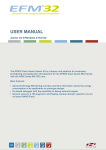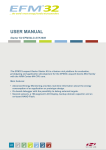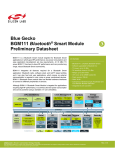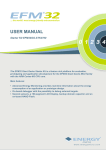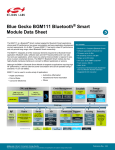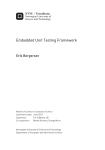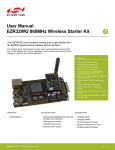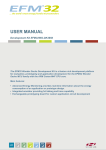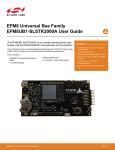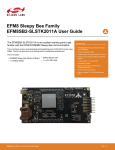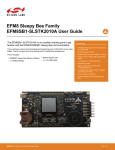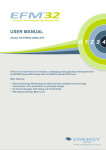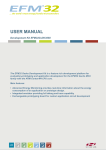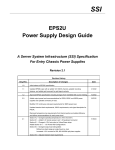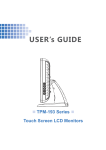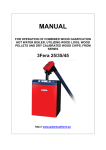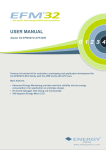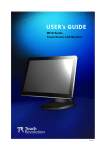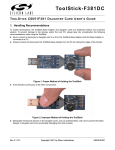Download EFM32ZG-STK3200 Zero Gecko Starter Kit User`s Guide
Transcript
...the world's most energy friendly microcontrollers USER MANUAL Starter Kit EFM32ZG-STK3200 The EFM32 Zero Gecko Starter Kit is a feature rich platform for evaluation, prototyping and application development for the EFM32 Zero Gecko MCU family with the ARM Cortex-M0+ CPU core. Main features: • Silicon Labs EFM32 Zero Gecko Microcontroller with 32 KB Flash and 4KB RAM EFM32ZG222F32. • Advanced Energy Monitoring provides real-time information about the energy consumption of an application or prototype design. • On-board debugger with the possiblity to debug external targets. • 128x128 pixel Memory-TFT LCD • Expansion Header and Breakout Pads for easy prototyping of custom hardware. ...the world's most energy friendly microcontrollers 1 Introduction 1.1 Description The EFM32ZG-STK3200 is an excellent starting point to get familiar with the EFM32 Zero Gecko microcontrollers. The kit contains a few buttons and LEDs, some capactive touch pads and a very low power Memory LCD-TFT display. In addition to demonstrating the EFM32 Zero Gecko's capabilities, the kit can also serve as a good starting point for application development. 1.2 Features • • • • • • • • • • EFM32ZG222F32 MCU with 32 KB Flash and 4 KB RAM. Advanced Energy Monitoring system for precise current tracking. Integrated SEGGER J-Link USB debugger/emulator with debug out functionality. 20 pin expansion header. Breakout pads for easy access to I/O pins. Power sources include USB and CR2032 battery. 2 user buttons, 2 user LEDs 2 capacitve touch pads Ultra low power 128x128 pixel Memory-LCD Crystals for LFXO and HFXO: 32.768kHz and 24.000MHz. 1.3 Getting Started The first step to get started with your new EFM32ZG-STK3200 is to go to [http://www.energymicro.com/simplicity] The Simplicity Studio software package contains all the tools, drivers, software examples and documentation needed to use the EFM32 Zero Gecko Starter Kit. Some important tools for use with the EFM32ZG-STK3200 are: • energyAware Commander • energyAware Profiler The energyAware Commander is a tool for updating the kit's firmware, programming the MCU and launching demos. The energyAware Profiler is the PC-side interface to the Advanced Energy Monitor. It provides the possibility to do real-time voltage and current monitoring of a running user application. 2013-10-08 - t0032_1.00 2 www.silabs.com ...the world's most energy friendly microcontrollers 2 Kit Block Diagram An overview of the EFM32 Zero Gecko Starter Kit is shown in Figure 2.1 (p. 3) Figure 2.1. EFM32ZG-STK3200 Block Diagram 2013-10-08 - t0032_1.00 3 www.silabs.com ...the world's most energy friendly microcontrollers 3 Kit Hardware Layout The layout of the EFM32 Zero Gecko Starter Kit is shown below. Figure 3.1. EFM32ZG-STK3200 hardware layout 2013-10-08 - t0032_1.00 4 www.silabs.com ...the world's most energy friendly microcontrollers 4 Power Supply and Reset 4.1 MCU Power Selection The EFM32 Zero Gecko MCU on the EFM32ZG-STK3200 is designed to be powered by different sources: • Through the on-board debugger. • By a 3V Battery. • An externally applied power source. Selecting the power source is done with the slide switch in the lower left corner of the board. Figure 4.1 (p. 5) shows how the different power sources can be selected with the slide switch. Figure 4.1. EFM32ZG-STK3200 Power Switch With the switch in the DBG position, an on-board low noise LDO with a fixed output voltage of 3.3V is used to power the MCU. This LDO sources power from the J-Link USB connector. The Advanced Energy Monitor is now also connected in series, allowing accurate high speed current measurements and energy debugging/profiling. With the switch in the BAT position, a 20mm coin cell battery in the CR2032 socket can be used to power the device. Finally, an external power supply can also be connected to the VMCU and GND pins either on the Expansion Header, or the breakout pads. For this to work the switch must be in the BAT position, and there should be no battery in the battery holder. See Chapter 10 (p. 14) to find the VMCU and GND pin locations. Note The Advanced Energy Monitor can only measure the current consumption of the EFM32 when the power selection switch is in the DBG position. 4.2 Board Controller Power The Board Controller is responsible for important features such as the debugger and the Advanced Energy Monitor, and is powered exclusively through the USB port in the top left corner of the board. This part of the kit resides on a separate power domain, so a different power source can be selected for the MCU while retaining debugging functionality. This power domain is also isolated to prevent current leakage from the MCU power domain when power to the Board Controller is removed. 2013-10-08 - t0032_1.00 5 www.silabs.com ...the world's most energy friendly microcontrollers 4.3 MCU Reset The EFM32 MCU can be reset by a few different sources: • The RESET button. • Through the debugger, either on-board or external. 4.4 Board Controller Reset The Board Controller can be reset by removing and re-inserting the J-Link USB cable. Removing the Board Controller USB cable will not reset the EFM32, but whenever the Board Controller is powered up again, it will issue a RESET to the EFM32 through the on-board debugger. 2013-10-08 - t0032_1.00 6 www.silabs.com ...the world's most energy friendly microcontrollers 5 Peripherals The starter kit has a set of peripherals that showcase some of the features of the EFM32 Zero Gecko microcontroller. Be aware that most EFM32 I/O routed to peripherals are also routed to the breakout pads. This must be taken into consideration when using the breakout pads for your application. 5.1 Push Buttons and LEDs The kit has two user push buttons marked PB0 and PB1. They are connected to the EFM32, and are debounced by RC filters with a time constant of 1ms. The buttons are connected to pins PC8 and PC9. In addition to the two push buttons, the kit also features two yellow LEDs marked LED0 and LED1, that are controlled by GPIO pins on the EFM32. The LEDs are connected to pins PC10 and PC11 in an active-high configuration. Figure 5.1. Buttons/LEDs 5.2 Memory LCD-TFT Display A 1.28-inch SHARP Memory LCD-TFT has been added to the board to enable interactive applications to be developed. The display has a high resolution of 128 by 128 pixels, and consumes very little power. It is a reflective monochrome display, so each pixel can only be light or dark, and no backlight is needed in normal daylight conditions. The display interface consists of an SPI-compatible serial interface and some extra control signals. Data is sent to the display one line (128 bits) at a time. The Memory LCD-TFT display is shared with the kit Board Controller, allowing the Board Controller application to display usefull information when the user application is not using the display. The user application always controls ownership of the display with EFM_DISP_SELECT (PA8): • 0: The Board Controller has control of the display • 1: The user application (EFM32) has control of the display EFM_DISP_PWR (PA10) enables power to the display, and must be set high in order to use the display. Data is clocked in on EFM_DISP_MOSI (PD7) when EFM_DISP_CS (PE11) is high, and the clock is sent on EFM_DISP_SCLK (PC15). The maximum supported clock speed is 1.1 MHz. EFM_DISP_COM (PE10) is the "COM Inversion" line. It must be pulsed periodically to prevent static build-up in the display itself. Please refer to the display application information for details on driving the display: http://www.sharpmemorylcd.com/resources/LS013B7DH03_Application_Info.pdf 2013-10-08 - t0032_1.00 7 www.silabs.com ...the world's most energy friendly microcontrollers Figure 5.2. 128x128 pixel Memory LCD 5.3 Capacitive Touch Pads Two touch pads T1 and T2 utilizing the capacitive touch capability of the EFM32 are available. They are located on the lower right side of the board, beneath the EFM32. The pads are connected to PC3 and PC4. Figure 5.3. Touch Pads The capacitive touch pads work by sensing changes in the capacitance of the pads when touched by a human finger. Sensing the changes in capacitance is done by setting up the touch pad as part of an RC relaxation oscillator using the EFM32's analog comparator, and then counting the number of oscillations during a fixed period of time. 2013-10-08 - t0032_1.00 8 www.silabs.com ...the world's most energy friendly microcontrollers 6 Advanced Energy Monitor 6.1 Usage The AEM (Advanced Energy Monitor) data is collected by the board controller and can be displayed by the energyAware Profiler, available through Simplicity Studio. By using the energyAware Profiler, current consumption and voltage can be measured and linked to the actual code running on the EFM32 in realtime. 6.2 AEM theory of operation In order to be able to accurately measure current ranging from 0.1uA to 50mA (114dB dynamic range), a current sense amplifier is utilized together with a dual gain stage. The current sense amplifier measures the voltage drop over a small series resistor, and the gain stage further amplifies this voltage with two different gain settings to obtain two current ranges. The transition between these two ranges occurs around 250uA. Digital filtering and averaging is done within the Board Controller before the samples are exported to the energyAware Profiler application. During startup of the kit, an automatic calibration of the AEM is performed. This calibration compensates for the offset error in the sense amplifiers. Figure 6.1. Advanced Energy Monitor 6.3 AEM accuracy and performance The Advanced Energy Monitor is capable of measuring currents in the range of 0.1uA to 50mA. For currents above 250uA, the AEM is accurate within 0.1mA. When measuring currents below 250uA, the accuracy increases to 1uA. Even though the absolute accuracy is 1uA in the sub 250uA range, the AEM is able to detect changes in the current consumption as small as 100nA. The AEM produces 6250 current samples per second. Note The current measurement will only be correct when powering the EFM32 from USB power through the debugger (power select switch set to "DBG"). 2013-10-08 - t0032_1.00 9 www.silabs.com ...the world's most energy friendly microcontrollers 7 Board Controller The kit contains a board controller that is responsible for performing various board-level tasks, such as handling the debugger and the Advanced Energy Monitor. An interface is provided between the EFM32 and the board controller in the form of a UART connection. The connection is enabled by setting the EFM_BC_EN (PD7) line high, and using the lines EFM_BC_TX (PD4) and EFM_BC_RX (PD5) for communicating. Specific library functions have been provided in the kit Board Support Package that support various requests to be made to the board controller, such as quering AEM voltage or current. To use these functions, the Board Support Package must be installed. See the Chapter 9 (p. 12) to find out more. Note The board controller is only available when USB power is connected. 2013-10-08 - t0032_1.00 10 www.silabs.com ...the world's most energy friendly microcontrollers 8 Debugging The EFM32ZG-STK3200 contains an integrated debugger, which can be used to download code and debug the EFM32 Zero Gecko MCU. In addition to programming the microcontroller on the kit, the debugger can also be used to program and debug external Silicon Labs EFM32 devices. 8.1 Debug Modes Programming external devices is done by connecting to a target board through the provided Debug IN/OUT Connector, and by setting the debug mode to OUT. The same connector can also be used to connect an external emulator to the EFM32 MCU on the kit, by setting the debug mode to IN. A summary of the different supported debug modes are described in Table 8.1 (p. 11) . Table 8.1. Debug modes Mode Description Debug MCU In this mode the on-board debugger is connected to the EFM32 on the EFM32ZG-STK3200. Debug IN In this mode the on-board debugger is disconnected, and an external debugger can be connected to debug the EFM32 on the EFM32ZG-STK3200. Debug OUT In this mode the on-board debugger can be used to debug an EFM32 mounted in your own application. Selecting the active debug mode is done with a drop-down menu in the energyAware Commander tool, which is available through Simplicity Studio. 8.2 Debugging during battery operation When the EFM32 is powered by the battery and the J-Link USB is still connected, the on-board debug functionality is available. If the USB power is disconnected the Debug IN mode will stop working. To enable debugging when the USB cable is removed, connect an external debugger to the MCU Debug Header in the bottom right corner of the EFM32ZG-STK3200 instead of the Debug IN/OUT Connector. This header is connected directly to the EFM32's debug interface. The pinout of this header is shown in Chapter 10 (p. 14) . 2013-10-08 - t0032_1.00 11 www.silabs.com ...the world's most energy friendly microcontrollers 9 Board Support Package The Board Support Package (BSP) is a set of C source and header files that enables easy access to, and control over some board specific features. Compared to the Silicon Labs EFM32 development kit, the functionality is limited. Unless you need/want some of the functions contained in the BSP, there is really no need to include or use it. The EFM32 in the Starter Kit is fully usable without BSP support, and you can use all peripherals in the emlib without the BSP. The BSP uses EFM32 peripheral UART0, Location 1 (TX pin PD4, RX pin PD5) on baudrate 115200-8N-1 to communicate with the board controller. Note The BSP is only functional when the Starter Kit is USB-powered, using these function calls with USB disconnected will give unpredictable results. 9.1 Installation location When installing Simplicity Studio, the BSP will be installed in the user directory, typically in a location such as Win7: C:\Users\[username]\AppData\Roaming\energymicro\kits\EFM32ZG_STK3200\ or something similar (depending on your OS/Windows version). All files in the board support package are prefixed by stk. 9.2 Application Programming Interface To use the BSP, include the Starter Kit header file, like this: #include "bsp.h" All functions in the BSP are prefixed with BSP_. The main initialization routine is defined as void BSP_Init ( BSP_INIT_STK_BCUART ) and must be called before any access to the STK-functions. This function call will setup the UART communication channel with a 115200 baud rate. This baud rate depends on the current core clock, so correct clock configuration should be set before calling this function. float BSP_CurrentGet ( void ) Returns instant current usage in milliamperes. float BSP_VoltageGet ( void ) Returns instant voltage (VMCU) reading in volts. 9.3 Example Applications Under the kits/EFM32ZG_STK3200/examples folder in your installation directory, you will find an example program using the BSP, with corresponding project/Makefiles for the supported IDEs. The examples folder also contains examples showing how to use the different peripherals on the EFM32ZG-STK3200. 9.4 How to include in your own applications The easiest way to include the BSP in your application is to base your work on the example application that uses the BSP. The following items are recommended for correct configuration: 2013-10-08 - t0032_1.00 12 www.silabs.com ...the world's most energy friendly microcontrollers 1. Make sure you define the correct part number (i.e. EFM32ZG222F32) as a preprocessor defined symbol 2. Make sure you define the correct part number (i.e. EFM32ZG222F32) for your project file 3. Add and include the EFM32_CMSIS-files (startup_efm32.s, system_efm32.c, core_cm3.c) to your project 4. Add and include all BSP package .c-files, with the bsp-prefix to your project 5. Configure include paths to point at the CMSIS/CM3/CoreSupport and CMSIS/CM3/DeviceSupport/ EnergyMicro/EFM32 directories 6. Configure include paths to point to the kits/EFM32ZG_STK3200/bsp directory Make sure you call "BSP_Init()" early at startup, and you should be all set. 2013-10-08 - t0032_1.00 13 www.silabs.com ...the world's most energy friendly microcontrollers 10 Connectors 10.1 Breakout pads Many of the EFM32's pins are routed out to "breakout pads" at the top and bottom edges of the kit. A 2.54mm pitch pin header can be soldered in for easy access to these pins. Most I/O pins are available on these pads. Note Some of the breakout pads are shared by on-board EFM peripherals. The schematic must be consulted to make sure that it is okay to use a shared pin in your application. Figure 10.1. Breakout pads and Expansion Header 10.2 Expansion header On the right hand side of the board a right angle 20-pin expansion header is provided to allow connection of peripherals or plug-in boards. The connecter contains a number of I/O pins that can be used with most of the EFM32 Zero Gecko's features. Additionally, the VMCU, 3V3 and 5V power rails are also exported. Figure 10.1 (p. 14) shows the pin assignment of the expansion header. Although the actual pin mapping varies, the Expansion Headers are to a large extent functionally compatible across all Starter Kits. Some of the chip peripheral functions that are available on the Expansion Header are listed in table Table 10.1 (p. 15) . 2013-10-08 - t0032_1.00 14 www.silabs.com ...the world's most energy friendly microcontrollers Figure 10.2. Expansion Header Table 10.1. Some peripheral functions available on Expansion Header Peripheral Peripheral pin MCU Pin EXP Header pin number USART/SPI USART1_TX PD7 4 USART1_RX PD6 6 USART1_CLK PC15 8 USART1_CS PC14 10 I2C0_SDA PE12 16 I2C0_SCL PE13 15 LEUART0_TX PD4 12 LEUART0_RX PD5 14 ADC0_CH4 PD4 12 ADC0_CH5 PD5 14 ADC0_CH6 PD6 6 ADC0_CH7 PD7 4 Current DAC IDAC0_OUT PB11 11 Analog Comparator ACMP0_CH0 PC0 3 ACMP0_CH1 PC1 5 ACMP0_CH2 PC2 7 I²C Low Energy UART Analog to Digital Converter Note Please note that this table only sums up some of the alternate functions available on the expansion header. Consult the EFM32ZG222F32 datasheet for a complete list of alternate functions. 2013-10-08 - t0032_1.00 15 www.silabs.com ...the world's most energy friendly microcontrollers 10.3 Debug IN/OUT Connector This connector is used for Debug In and Debug Out (see Section 8.1 (p. 11) ). The pinout is described in Table 10.2 (p. 16) . Figure 10.3. Debug IN/OUT Connector Table 10.2. Debug IN/OUT Connector Pinout Pin number Function Note 1 VTARGET Target voltage on the debugged application. 2 NC Not Connected 3 #TRST JTAG tap reset 5 TDI JTAG data in 7 TMS/SWDIO JTAG TMS or Serial Wire data I/O 9 TCK/SWCLK JTAG TCK or Serial Wire clock 11 RTCK JTAG RTCK 13 TDO/SWO JTAG TDO or Serial Wire Output 15 #RESET Target MCU reset 17 PD This pin has a 100k pulldown. 18 Cable detect This signal must be pulled to ground by the external debugger or application for cable insertion detection. 19 PD This pin has a 100k pulldown. 4, 6, 8, 10, 12, 14, 16, 20 GND Note Although the Debug IN/OUT Connector can support JTAG debugging of external targets, the EFM32-series of devices do not support JTAG. Any external debugger used with the Debug IN/OUT Connector in "Debug IN" mode must therefore use Serial Wire Debug. 2013-10-08 - t0032_1.00 16 www.silabs.com ...the world's most energy friendly microcontrollers 10.4 MCU Debug Header A header with direct connections to the EFM32 Zero Gecko MCU debug interface is provided on the lower rightmost side of the PCB. The header is not mounted by default, but a 10-pin, 1.27mm pitch through-hole header can be soldered on to allow a SWD debugger to be connected. Since this connector is directly connected to the EFM32's debug pins, it allows debugging of the target even if the Board Controller is not powered. Figure 10.4. MCU Debug Header Table 10.3. MCU Debug Header Pinout Pin number Function Note 1 VMCU MCU supply voltage 2 SWDIO/TMS Serial Wire Data Input/Output 4 SWCLK/TCK Serial Wire Clock input 6 SWO/TDO Not Connected on the EFM32ZG-STK3200 10 nRESET Target CPU reset signal 7, 8 NC Not Connected 3, 5, 9 GND 2013-10-08 - t0032_1.00 17 www.silabs.com ...the world's most energy friendly microcontrollers 11 Integrated Development Environments The Energy Micro software packages contain various examples in source form to use with the Starter Kit. The following IDEs are supported. 11.1 IAR Embedded Workbench for ARM An evaluation version of IAR Embedded Workbench for ARM is included on a CD in the EFM32ZGSTK3200 package. Check the quick start guide for where to find updates, and IAR's own documentation on how to use it. You will find the IAR project file in the iar subfolder of each project 11.2 Atollic TrueSTUDIO for ARM See the quick start guide for download details for Atollic TrueSTUDIO for ARM. You will find TrueStudio project files in the atollic subfolder of each project. 11.3 Rowley Associates - CrossWorks for ARM See the quick start guide for download details for CrossWorks for ARM. You will find CrossWorks project files in the rowley subfolder of each project. 11.4 CodeSourcery - Sourcery G++ See the quick start guide for download details for Sourcery G++. The codesourcery subfolder contains Makefiles for use with the Sourcery G++ development environment. 11.5 Keil - MDK-ARM See the quick start guide for download details for evaluation versions of Keil MDK-ARM. The arm subfolder in each project contains project files for MDK-ARM. Please see the MDK-ARM documentation for usage details. 2013-10-08 - t0032_1.00 18 www.silabs.com ...the world's most energy friendly microcontrollers 12 energyAware Commander and Upgrades The energyAware Commander is a program that comes with Simplicity Studio. It can perform various kit and EFM32 specific tasks. 12.1 eA Commander Operation This utility gives the ability to program the EFM32, upgrade the kit, lock and unlock devices and more. Some of the features will only work with Energy Micro kits, while other will work with a generic J-Link debugger connected. Press the "F1" button, or select the "Help->Help" menu item for a full description. Figure 12.1. energyAware Commander 12.2 Firmware Upgrades Upgrading the kit firmware is done through Simplicity Studio. The Studio will automatically check for new updates on startup. You can also use the energyAware Commander for manual upgrades. Select the "Kit" icon, use the "Browse" button to select the correct file ending in ".emz", and press the "Install package button". 2013-10-08 - t0032_1.00 19 www.silabs.com ...the world's most energy friendly microcontrollers 13 Schematics, Assembly Drawings and BOM The schematics, assembly drawings and bill of materials (BOM) for the EFM32 Zero Gecko Starter Kit board are available through Simplicity Studio when the kit documentation package has been installed. 2013-10-08 - t0032_1.00 20 www.silabs.com ...the world's most energy friendly microcontrollers 14 Kit Revision History and Errata 14.1 Revision History The kit revision can be found printed on the box label of the kit, as outlined in the figure below. Figure 14.1. Revision info Table 14.1. Kit Revision History Kit Revision Released Description A00 20.09.2013 Initial Kit Revision. 14.2 Errata Table 14.2. Kit Errata Kit Revision 2013-10-08 - t0032_1.00 Problem Description 21 www.silabs.com ...the world's most energy friendly microcontrollers 15 Document Revision History Table 15.1. Document Revision History Revision Number Effective Date Change Description 1.00 08.10.2013 Initial document version. 2013-10-08 - t0032_1.00 22 www.silabs.com ...the world's most energy friendly microcontrollers A Disclaimer and Trademarks A.1 Disclaimer Silicon Laboratories intends to provide customers with the latest, accurate, and in-depth documentation of all peripherals and modules available for system and software implementers using or intending to use the Silicon Laboratories products. Characterization data, available modules and peripherals, memory sizes and memory addresses refer to each specific device, and "Typical" parameters provided can and do vary in different applications. Application examples described herein are for illustrative purposes only. Silicon Laboratories reserves the right to make changes without further notice and limitation to product information, specifications, and descriptions herein, and does not give warranties as to the accuracy or completeness of the included information. Silicon Laboratories shall have no liability for the consequences of use of the information supplied herein. This document does not imply or express copyright licenses granted hereunder to design or fabricate any integrated circuits. The products must not be used within any Life Support System without the specific written consent of Silicon Laboratories. A "Life Support System" is any product or system intended to support or sustain life and/or health, which, if it fails, can be reasonably expected to result in significant personal injury or death. Silicon Laboratories products are generally not intended for military applications. Silicon Laboratories products shall under no circumstances be used in weapons of mass destruction including (but not limited to) nuclear, biological or chemical weapons, or missiles capable of delivering such weapons. A.2 Trademark Information Silicon Laboratories Inc., Silicon Laboratories, the Silicon Labs logo, Energy Micro, EFM, EFM32, EFR, logo and combinations thereof, and others are the registered trademarks or trademarks of Silicon Laboratories Inc. ARM, CORTEX, Cortex-M3 and THUMB are trademarks or registered trademarks of ARM Holdings. Keil is a registered trademark of ARM Limited. All other products or brand names mentioned herein are trademarks of their respective holders. 2013-10-08 - t0032_1.00 23 www.silabs.com ...the world's most energy friendly microcontrollers B Contact Information Silicon Laboratories Inc. 400 West Cesar Chavez Austin, TX 78701 Please visit the Silicon Labs Technical Support web page: http://www.silabs.com/support/pages/contacttechnicalsupport.aspx and register to submit a technical support request. 2013-10-08 - t0032_1.00 24 www.silabs.com ...the world's most energy friendly microcontrollers Table of Contents 1. Introduction .............................................................................................................................................. 2 1.1. Description .................................................................................................................................... 2 1.2. Features ....................................................................................................................................... 2 1.3. Getting Started ............................................................................................................................... 2 2. Kit Block Diagram ..................................................................................................................................... 3 3. Kit Hardware Layout .................................................................................................................................. 4 4. Power Supply and Reset ............................................................................................................................ 5 4.1. MCU Power Selection ..................................................................................................................... 5 4.2. Board Controller Power .................................................................................................................... 5 4.3. MCU Reset ................................................................................................................................... 6 4.4. Board Controller Reset .................................................................................................................... 6 5. Peripherals ............................................................................................................................................... 7 5.1. Push Buttons and LEDs ................................................................................................................... 7 5.2. Memory LCD-TFT Display ................................................................................................................ 7 5.3. Capacitive Touch Pads .................................................................................................................... 8 6. Advanced Energy Monitor ........................................................................................................................... 9 6.1. Usage ........................................................................................................................................... 9 6.2. AEM theory of operation .................................................................................................................. 9 6.3. AEM accuracy and performance ........................................................................................................ 9 7. Board Controller ...................................................................................................................................... 10 8. Debugging .............................................................................................................................................. 11 8.1. Debug Modes ............................................................................................................................... 11 8.2. Debugging during battery operation .................................................................................................. 11 9. Board Support Package ............................................................................................................................ 12 9.1. Installation location ........................................................................................................................ 12 9.2. Application Programming Interface ................................................................................................... 12 9.3. Example Applications ..................................................................................................................... 12 9.4. How to include in your own applications ............................................................................................ 12 10. Connectors ........................................................................................................................................... 14 10.1. Breakout pads ............................................................................................................................ 14 10.2. Expansion header ........................................................................................................................ 14 10.3. Debug IN/OUT Connector ............................................................................................................. 16 10.4. MCU Debug Header .................................................................................................................... 17 11. Integrated Development Environments ....................................................................................................... 18 11.1. IAR Embedded Workbench for ARM ............................................................................................... 18 11.2. Atollic TrueSTUDIO for ARM ......................................................................................................... 18 11.3. Rowley Associates - CrossWorks for ARM ....................................................................................... 18 11.4. CodeSourcery - Sourcery G++ ....................................................................................................... 18 11.5. Keil - MDK-ARM ......................................................................................................................... 18 12. energyAware Commander and Upgrades ................................................................................................... 19 12.1. eA Commander Operation ............................................................................................................. 19 12.2. Firmware Upgrades ..................................................................................................................... 19 13. Schematics, Assembly Drawings and BOM ................................................................................................. 20 14. Kit Revision History and Errata ................................................................................................................. 21 14.1. Revision History .......................................................................................................................... 21 14.2. Errata ........................................................................................................................................ 21 15. Document Revision History ...................................................................................................................... 22 A. Disclaimer and Trademarks ....................................................................................................................... 23 A.1. Disclaimer ................................................................................................................................... 23 A.2. Trademark Information ................................................................................................................... 23 B. Contact Information ................................................................................................................................. 24 B.1. ................................................................................................................................................. 24 2013-10-08 - t0032_1.00 25 www.silabs.com ...the world's most energy friendly microcontrollers List of Figures 2.1. EFM32ZG-STK3200 Block Diagram ........................................................................................................... 3 3.1. EFM32ZG-STK3200 hardware layout .......................................................................................................... 4 4.1. EFM32ZG-STK3200 Power Switch ............................................................................................................. 5 5.1. Buttons/LEDs ......................................................................................................................................... 7 5.2. 128x128 pixel Memory LCD ...................................................................................................................... 8 5.3. Touch Pads ........................................................................................................................................... 8 6.1. Advanced Energy Monitor ........................................................................................................................ 9 10.1. Breakout pads and Expansion Header ..................................................................................................... 14 10.2. Expansion Header ............................................................................................................................... 15 10.3. Debug IN/OUT Connector ..................................................................................................................... 16 10.4. MCU Debug Header ............................................................................................................................ 17 12.1. energyAware Commander ..................................................................................................................... 19 14.1. Revision info ...................................................................................................................................... 21 2013-10-08 - t0032_1.00 26 www.silabs.com ...the world's most energy friendly microcontrollers List of Tables 8.1. Debug modes ....................................................................................................................................... 10.1. Some peripheral functions available on Expansion Header .......................................................................... 10.2. Debug IN/OUT Connector Pinout ............................................................................................................ 10.3. MCU Debug Header Pinout ................................................................................................................... 14.1. Kit Revision History ............................................................................................................................. 14.2. Kit Errata ........................................................................................................................................... 15.1. Document Revision History ................................................................................................................... 2013-10-08 - t0032_1.00 27 11 15 16 17 21 21 22 www.silabs.com




























